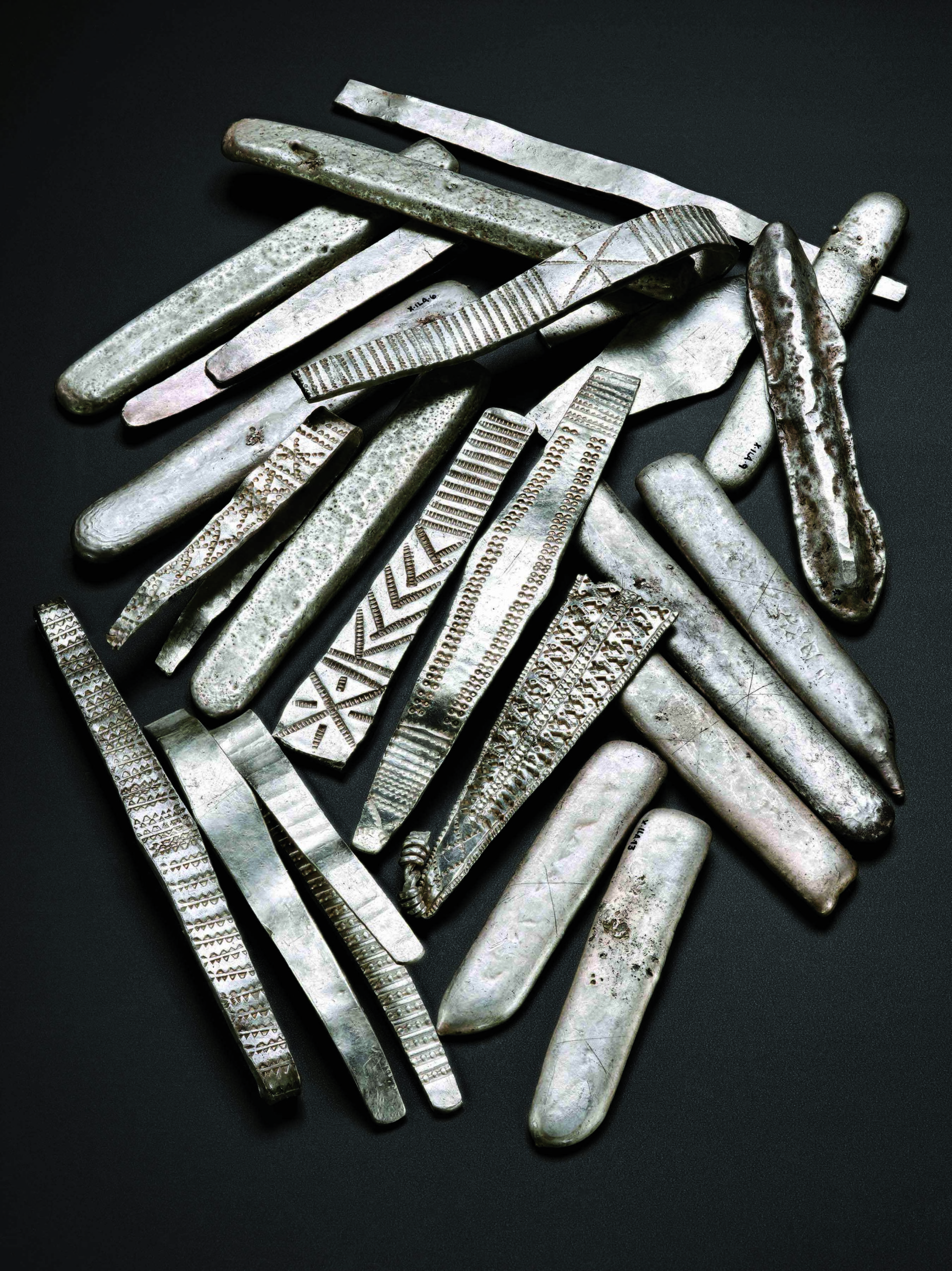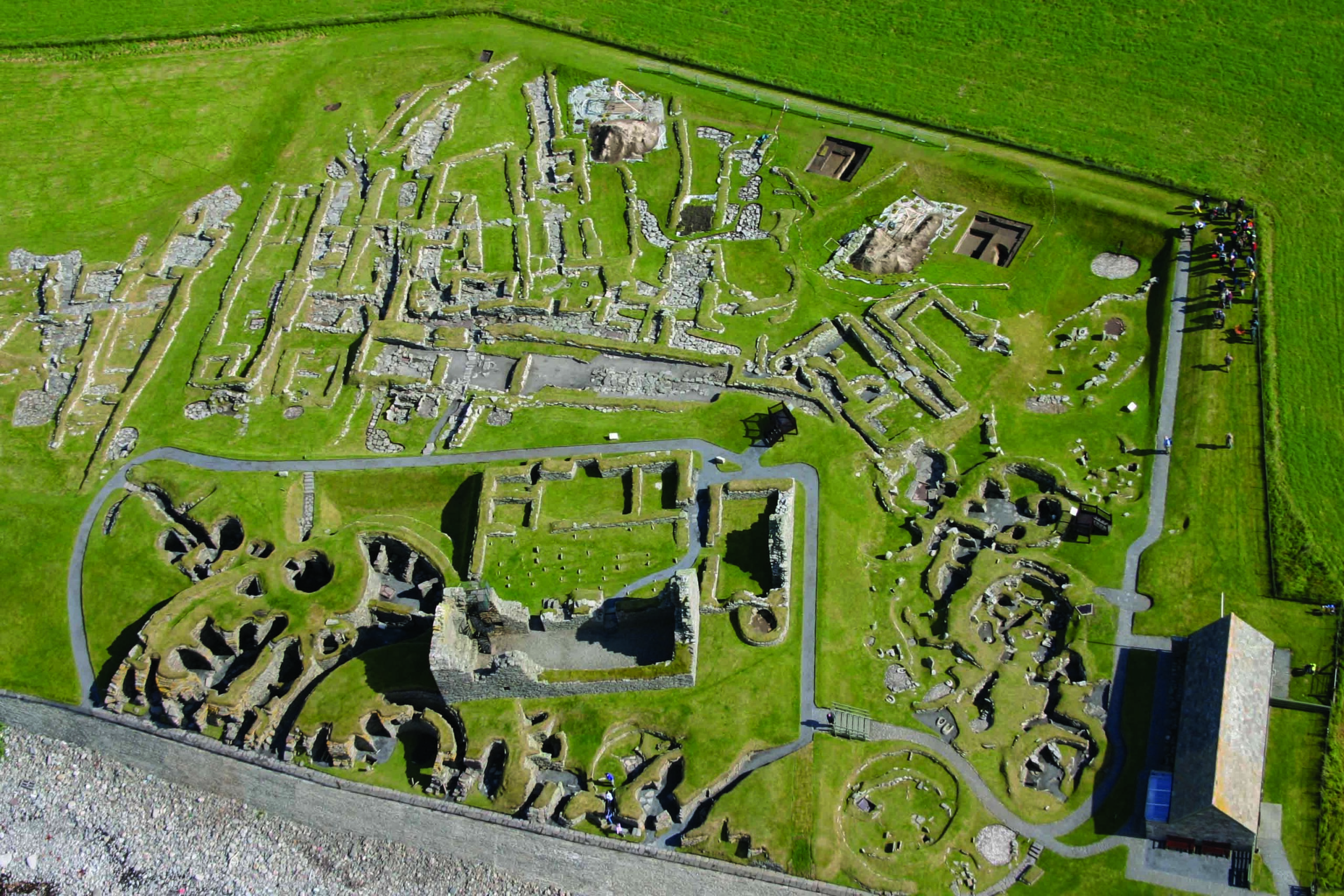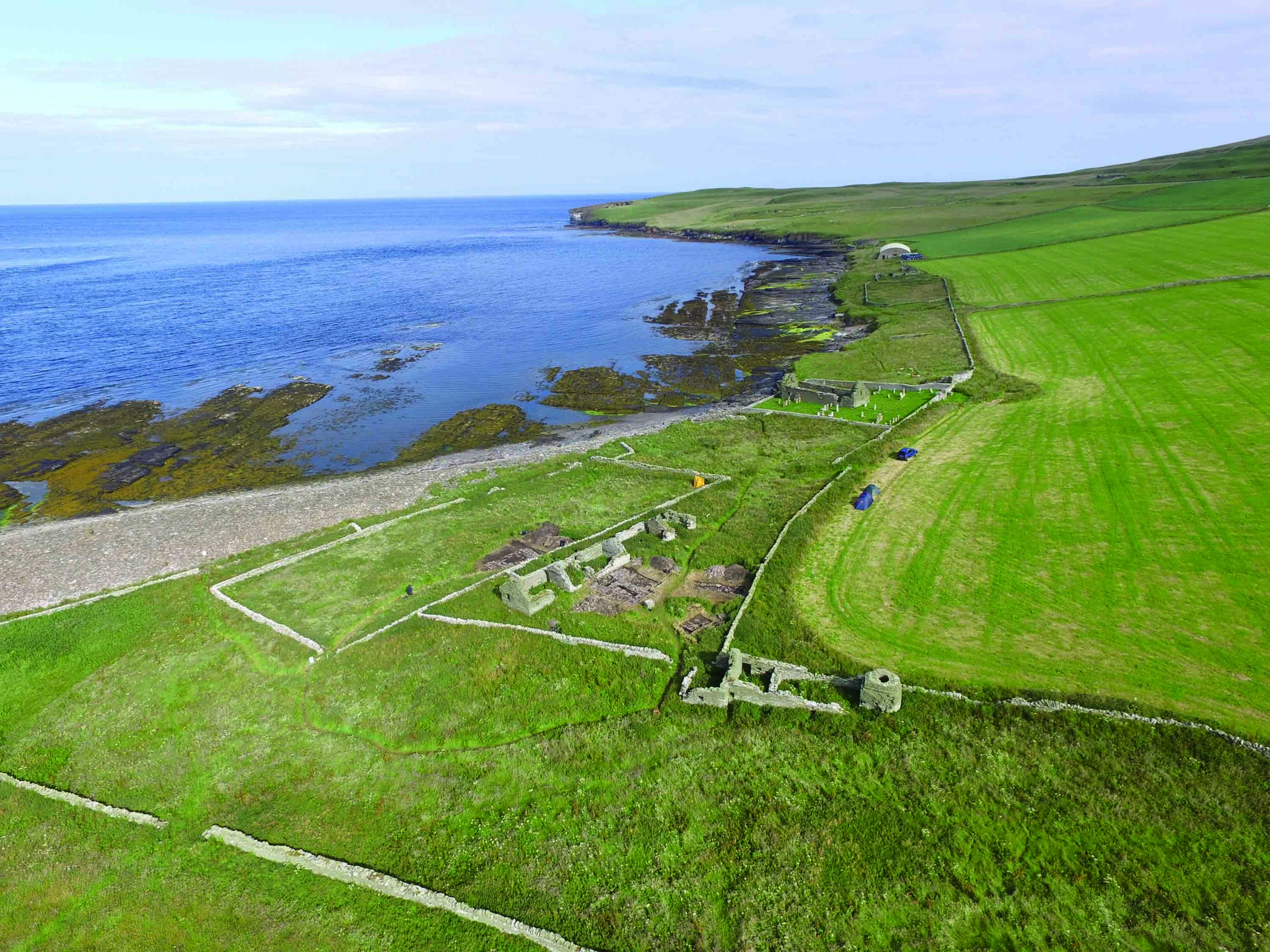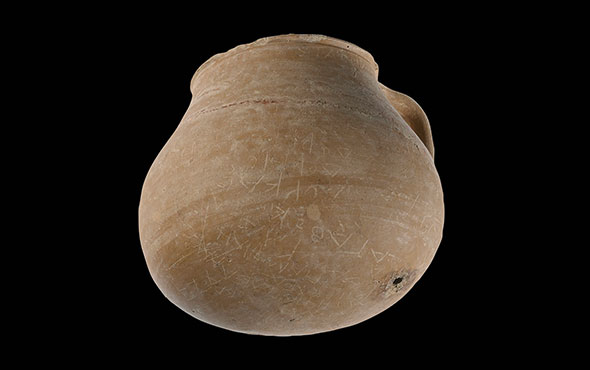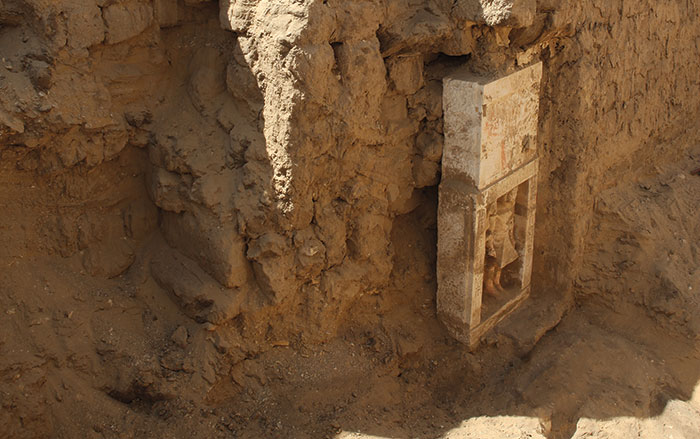
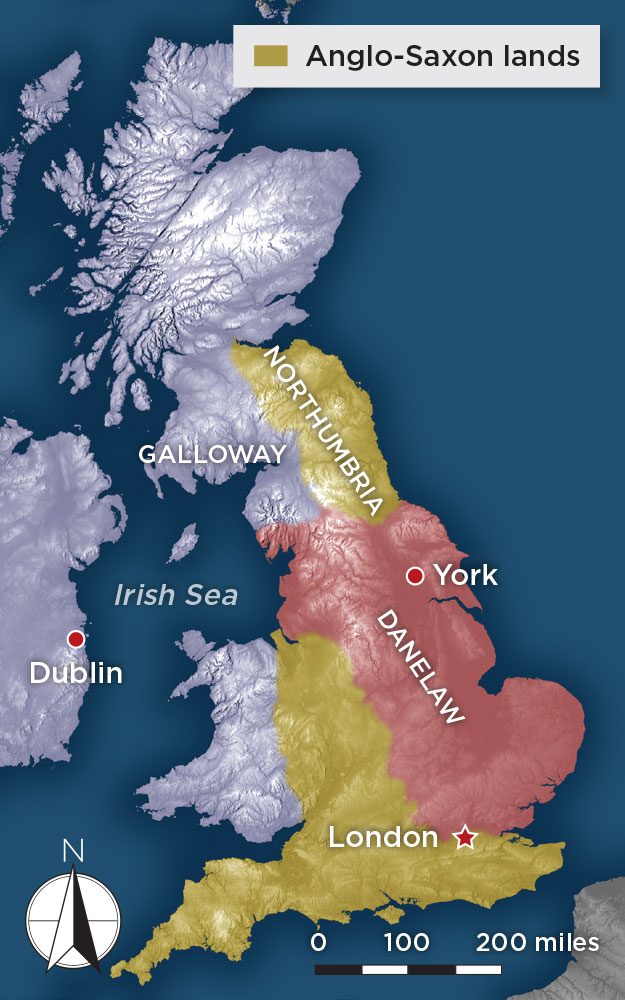
When it comes to Viking hoards, archaeologists know to expect the unexpected. Hundreds of these caches containing tens of thousands of objects that were hidden for safekeeping and never reunited with their erstwhile owners have been found buried beneath fields throughout Scandinavia and across Great Britain and Ireland. While many Viking hoards share similar characteristics—notably large quantities of silver—no two are identical. Thus, when a new trove is unearthed, what it might yield is endlessly unpredictable.
Almost from the very moment it was discovered eight years ago in southwestern Scotland, in the region of Galloway, a particularly enigmatic collection of early medieval objects has evoked the sense of finding something truly unexpected. Discovered near Balmaghie, in the historical county of Kirkcudbrightshire, the assemblage, now known as the Galloway Hoard, dates to about A.D. 900. Numbering around 100 artifacts, it is the richest, most diverse, and most curious collection of Viking Age (ca. A.D. 793–1066) artifacts ever unearthed in Great Britain or Ireland. While it consists of no less than 10 pounds of Viking silver, it also boasts Anglo-Saxon jewelry, religious relics, precious heirlooms, and the largest collection of Viking Age gold objects found anywhere in the British Isles. These artifacts, which span the pagan and ecclesiastical and the Viking and Anglo-Saxon worlds, continue to astonish the researchers who are still trying to understand the hoard’s unprecedented elements. “Anything that you look at in this hoard has something unusual about it,” says Martin Goldberg, principal curator of medieval archaeology and history at National Museums Scotland. “There’s a whole range of things that we have never seen before.”
In 2014, an amateur metal detectorist surveying Church of Scotland land located a number of silver artifacts buried in a shallow pit. He notified local authorities, and an archaeological team was dispatched to the site, where they subsequently unearthed 22 ancient silver objects. The collection seemed to have all the markings of a Viking hoard. “The Vikings had an insatiable demand for silver,” says University of Oxford archaeologist Jane Kershaw. “They used it in lots of different ways—for display purposes, as a statement of wealth, and as currency.”
In the 400 years between the decline of the Roman presence in Britain and the Vikings’ arrival in the late eighth century A.D., silver had been relatively scarce on the island. But when the Scandinavians began to permanently settle in the British Isles and take over land formerly belonging to Anglo-Saxon kingdoms, they brought huge quantities of silver with them, often acquired through trade with the Islamic caliphates to the east. “New sources of silver were coming into Britain, which is why the Viking Age is sometimes referred to as the Silver Age,” says Goldberg. People often buried their silver at this unsettled time as a way of safeguarding their wealth, creating subterranean bank deposits that could be added to over time, or of hiding their valuables in the face of roving bands of dangerous raiders. Many of these stashes were never retrieved.
EXPAND
A Golden Bird
Among the Galloway Hoard’s many surprises was a trio of rare gold objects that had been placed in a wooden box and concealed within a cluster of four silver Viking arm rings. This mini-hoard consisted of an ingot, a ring, and a finely crafted bird-shaped pin. On first glance, the bird resembles a flamingo—it has a large, curved beak, and the thinness of the pin’s shaft is reminiscent of the flamingo’s long, spindly legs. However, other features are depicted less accurately, which is understandable given that the craftsperson who made the object had likely never seen a flamingo—the nearest specimens would have lived hundreds of miles away along the shores of the Mediterranean Sea.
According to Martin Goldberg, principal curator of medieval archaeology and history at National Museums Scotland, the bird may not have been intended to represent a flamingo at all, but instead the mythical phoenix. “There’s a connection in the ancient world between the flamingo and the phoenix,” Goldberg says. This likely stems from the flamingo’s ability, like that of the phoenix, to survive in hot, inhospitable climates. “Obviously, a phoenix doesn’t exist, so people had to piece together what they thought it would look like using the characteristics of a flamingo,” he adds.
The phoenix was commonly associated with gold, fire, the rising sun, and rebirth. Ancient mythological lore held that the bird was periodically reborn, a characteristic that Anglo- Saxon Christians used as an allegory for Christ’s resurrection. This small pin may have been valued for its gold—and as an emblem of Christian faith.
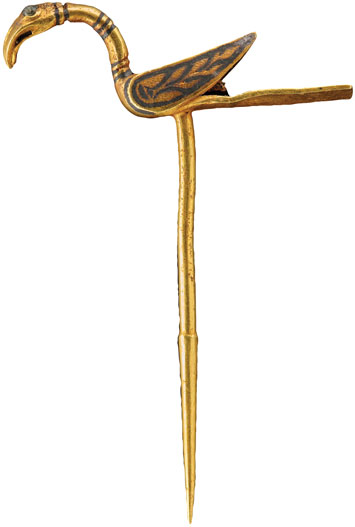
Initially, the Galloway Hoard appeared to be a standard Viking Age cache, with the exception of one item—a large silver cross with a spiral silver chain wrapped around it that appeared out of place. It would be the first sign that the Galloway Hoard was unlike all the others that had previously been unearthed. The second such sign occurred only a few hours later when the archaeologists reached a seemingly undisturbed layer of soil and gravel that appeared to signal that they had reached the bottom of the deposit. Thinking they had collected all the hoard’s contents, team members were packing up their tools when they made one final sweep with a metal detector to confirm they hadn’t left anything behind. To their great surprise, the device produced a signal in the area that had just been cleared. As excavators dug just a few inches deeper, they came across a second assemblage of artifacts that would prove to be three times as bountiful as the first. Whoever buried the Galloway Hoard had created a decoy layer to throw off would-be thieves. They must have imagined that if someone happened across the deposit of silver bullion near the surface, they might be content with their windfall and depart satisfied, while the bulk of the treasure remained safe below. It had nearly worked, even 1,000 years later. “The team wouldn’t have suspected that there was other material underneath if they hadn’t had that modern machinery with them,” says Goldberg.

The lower deposit contained 46 more pieces of silver, along with other unusual objects bundled up in separate parcels, although all signs continued to point to a Viking owner. While some of the silver was in the form of ingots, other pieces had been shaped into Viking-style arm rings, a type of decorated jewelry usually worn around the wrist. Such arm rings were also used as portable currency and could be broken into pieces known as hacksilver and used as payment for goods. “Wherever you get these arm rings and the hacksilver, it’s in places that are associated with Viking trade,” says Adrián Maldonado, Galloway Hoard researcher at National Museums Scotland. “When you get them in Scotland, you are generally safely in a Viking context.” These particular arm rings are of a type known as Hiberno-Scandinavian broad-band arm rings, which have mostly been found at sites in Ireland and date to between A.D. 880 and 930. This was the first time they had been found in Scotland. There was also a separate cluster of four fully shaped and elaborately decorated ribbon-style arm rings that had been worn and subsequently tied together and buried. Taken together, the Galloway Hoard represents the largest collection of ancient silver discovered in Scotland in 150 years. “It was unexpected because we had never had a big hoard from Galloway before,” says Maldonado. But this was just the beginning.
For several years following its discovery, the Galloway Hoard remained in a kind of limbo as Scottish authorities decided where it should be housed. Some conservation and preservation work was carried out, but scholars intensified their research in 2017 after the objects arrived at National Museums Scotland. When experts finally began to closely investigate the artifacts, they learned that there was much more to the Galloway Hoard than just Viking silver. They also began to suspect that the hoard might not, in fact, be Viking at all. “When it came out of the ground, the first thing that anybody saw was the piles and piles of silver, so for years after that it was only spoken of as a Viking hoard,” says Maldonado. “And then we started looking into the material.”

There were certain objects that seemed entirely anomalous in the context of a Viking hoard, such as a gold Anglo Saxon–style pin shaped like a bird (see “A Golden Bird”) and the cross that was found in the upper deposit. After it was cleaned and conserved, it became clear that the cross had been decorated using Anglo-Saxon zoomorphic and geometric designs popular in the kingdoms of southern Britain in the ninth century A.D. The cross has gold inlay and the symbols of the four Gospel writers etched onto its arms. According to Maldonado, the high level of craftwork and the quality and weight of the silver would have made the cross extremely rare and valuable. “It could only have been worn by an abbot, a bishop, or royalty,” he says. “Nobody else is getting such an ornate symbol of their faith.”
The inclusion of a cross in a Viking hoard was puzzling, even unprecedented. But there would soon be an even bigger twist. When researchers looked more closely at the Viking arm rings, they noticed that they could be divided into four types according to the way they were subtly shaped and bent. For example, some had slight folds on both ends, while others had folds on one end only. Furthermore, a single piece from each distinct group was inscribed, but the words were written using Anglo-Saxon runes, not Viking runes as the researchers had expected. The language, too, appeared to be Anglo-Saxon, not Scandinavian, and the objects seemed to be inscribed with abbreviations of Old English words frequently used as parts of names. One appeared to spell out BER, which may be short for Berwulf, while another bears the markings ED, which may represent the name Edward. This seemed to imply that the collection of silver had four owners, maybe Anglo-Saxons, who joined together to bury their personal wealth in one stash. This interpretation corresponds neatly with the four intact circular arm rings that were tied together. “Everything about it looks like it was four different people coming together to form an agreement that is sealed with this sacrifice of great wealth,” says Maldonado.
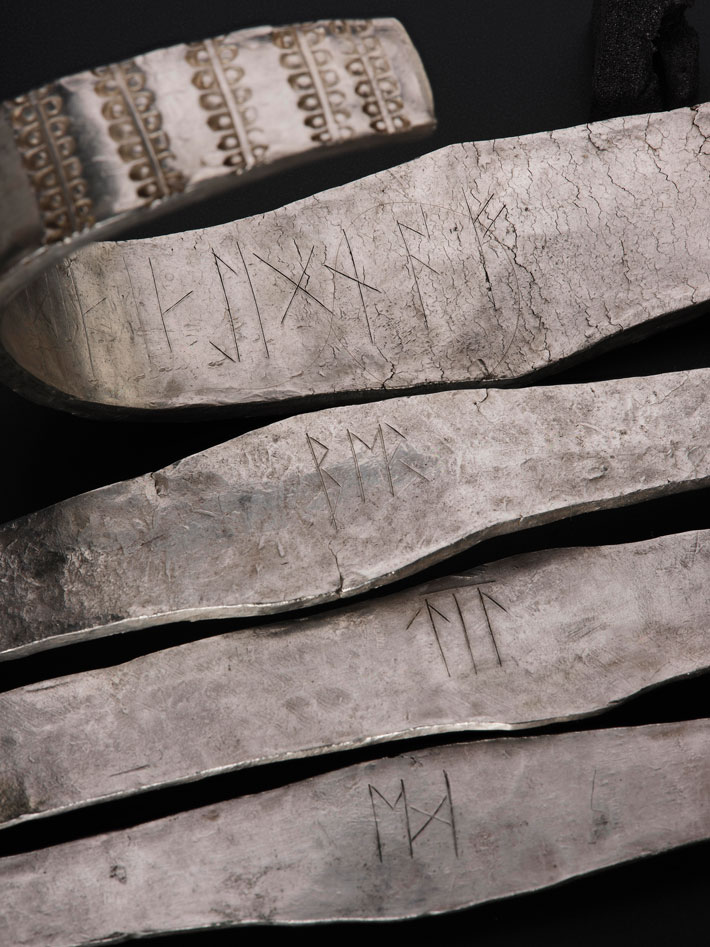
Yet the question of why a group of Anglo-Saxons would be in possession of and sign their names on such typical Viking silver objects remained unanswered. According to Kershaw, the scenario is unparalleled. “Typically, the Anglo-Saxons would not be using silver bullion,” she says. “Those things are not very useful to them since they have a strict coin-based economy.” The answer may lie in Galloway’s unique location and the tempest of geopolitical events playing out just outside its borders. Around the time the Galloway Hoard was deposited, the medieval kingdom of Scotland was just beginning to take shape to Galloway’s north, while a unified England made up of Anglo-Saxon kingdoms was forming for the first time in southern Britain under Alfred the Great (r. ca. A.D. 871–899) and his successors.
Galloway also found itself squeezed between two related but separate Viking kingdoms: one based in Dublin that controlled the Irish Sea and the Scottish west coast, and a group that controlled much of northern, central, and eastern Britain, territory that became known as the Danelaw and had its capital at Jorvik, modern-day York. Galloway was nominally still a part of Anglo-Saxon Northumbria, which had had its land greatly reduced by the Danes, but it was essentially cut off from other Anglo-Saxons in Britain and surrounded by Vikings. “Galloway is where these different cultures were meeting,” says Goldberg. “It’s not just Scandinavians, but people from Britain and Ireland as well.” The hoard’s silver reflects this critical era of interaction between Galloway’s Anglo-Saxon inhabitants and the Vikings on their doorstep. “I can imagine lots of pragmatic alliances,” says Kershaw. “I’d be happy to see the Vikings and the Anglo-Saxons maybe collaborating in some way. It’s just too weird an assemblage to make sense of otherwise.”
While the Galloway Hoard has astonished archaeologists from the start, its biggest surprise has been its most recent—an artifact that has also taken the hoard another step away from its original identification as Viking. Because of its delicate nature, this particular artifact took several years to fully investigate. It was a silver vase, buried alongside the silver ingots and arm rings in the lower deposit, with its lid in place, thereby sealing its contents. Although the vase measures just four inches high, it was packed with an eclectic assemblage of miniature riches that came together over hundreds of years and across thousands of miles. “The core of the Galloway Hoard, and where you get the most unusual range of materials, is this lidded vessel,” says Goldberg. “It contains items that you will not find in any other Viking Age hoard.”
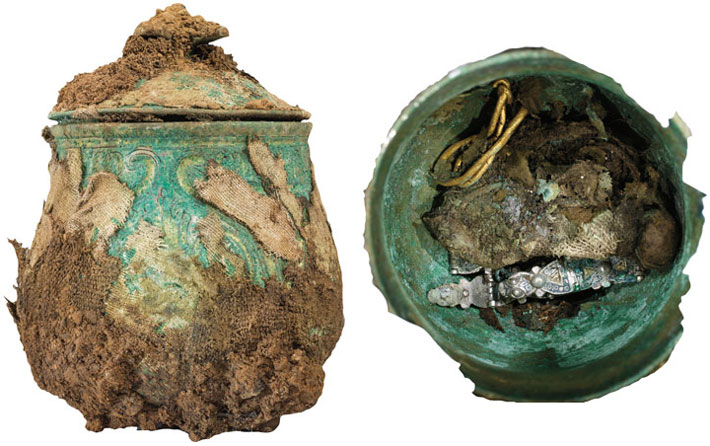
The vessel itself is an extraordinary work of artistry. Layers of textiles that were carefully wrapped around it when it was buried are still partially preserved and have yet to be removed so as not to damage them, but more than 1,000 X-rays have revealed the intricate designs engraved on its surface. They seem to depict Zoroastrian fire altars, winged crowns, and animals such as leopards and tigers, all common motifs associated with the Sasanian Empire, which ruled over modern-day Iran between A.D. 224 and 651. It’s likely that the vase was crafted in western Asia before it made its way along Viking trade routes and was buried in southwest Scotland several hundred years later, making it the first such vessel ever found so far from where it was fashioned. “A vessel like this has never made it this far west,” says Goldberg. “We are having to look wider and wider to find out where we think some of these things came from.”

The objects would only get more exotic as the researchers looked deeper into the vase. When researchers finally removed the lid in 2021, they discovered that the vase was full of treasures, including one of the largest surviving collections of late Anglo-Saxon metalwork. There were silver brooches, decorated bracelet-like hinged straps, and precious gold items. Perhaps the most remarkable item is a two-inch-tall jar made of rock crystal and gold that had been carefully wrapped in linen and placed into a pouch made of leather and silk. The silk, which originated in a market along the Eurasian Silk Road, is the earliest example ever found in Scotland.
Like many other items in the hoard, this small jar at first confused investigators. Rock crystal is very difficult to carve, and the methods for doing so had largely been forgotten in the western world after the decline of the Roman Empire. The art form would reemerge in Fatimid Egypt, but not until nearly 100 years after the Galloway Hoard was buried. The jar is also oddly shaped, with a round top, a square bottom, and several leaf-like protruding lobes. “We thought, ‘That’s quite weird for a jar,’” says Goldberg.
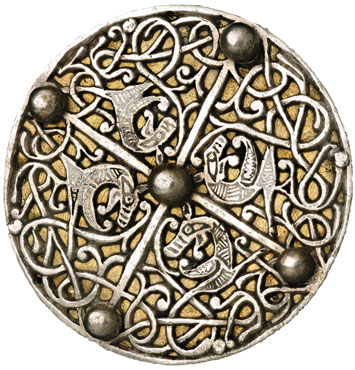
As soon as the researchers turned the vessel upside down, however, they had a revelation. When inverted, the carved rock crystal itself resembled the top of a classical Corinthian column. In ancient Rome, wealthy patrons occasionally commissioned architecturally inspired miniature artworks carved from rock crystal. Given its marked resemblance to a column capital and the rarity of rock-crystal art in the ninth century, the object was assuredly manufactured in the Roman Empire. Having survived for several centuries after the demise of the Romans, it was inverted and encased in a housing of fine Anglo-Saxon gold filigree. A spout was then attached to the top, and a tiny channel was filled with a precious liquid, likely either perfume or holy water. Researchers now even know who was responsible for transforming this tiny sculpture into a jar. Although difficult to discern with the naked eye, 3-D X-rays revealed a Latin inscription on the jar’s base: “Bishop Hyguald ordered [this] to be made.” There is no mention of a Bishop Hyguald in historical records, but Hyguald is a Northumbrian name that appears in contemporaneous church documents. “The story of that vessel is only beginning to be told now, but when you look at what’s inside the hoard, it’s looking more and more Northumbrian,” says Maldonado. “There is almost nothing left that is Viking about it.”
The silver and gold artifacts contained in the vase are extraordinary, but perhaps even more so are the objects with seemingly lesser conventional value. Nestled among the vase’s more valuable contents were items with little economic worth, including glass beads that were already centuries old when buried, and an assortment of other peculiar antique objects that Goldberg believes may have been family relics. “To me the collection in the vessel looks like heirlooms,” he says. “They’re things that are valued not because they are gold or silver or for their material wealth, but for their artistry and for how old they are.”
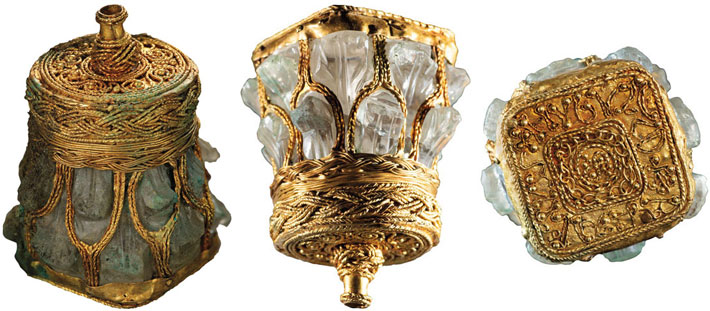
Included among these items are the Galloway Hoard’s most curious objects––two small balls of compacted earth that survived for more than a millennium thanks to the vessel’s airtight seal. Objects such as these normally would have dried out and fallen apart long ago. X-ray imaging revealed that, although they were made from ordinary dirt, the balls had tiny flecks of gold scattered throughout them. After some consideration, Goldberg and the team of researchers recalled similar objects in the Vatican Museums’ collections. During the early Middle Ages when pilgrims visited sacred sites in the Holy Land they sometimes took a small amount of mud and rubbed it in the dust on or beneath shrines, rolled it into a ball, and carried it home as a memento. Because many of the reliquaries that held these treasured souvenirs were gilded, the dust and dirt often picked up tiny specks of gold. It is likely that the delicate balls of dirt in the Galloway Hoard were transported hundreds of miles from the eastern Mediterranean to Scotland. “People always ask me, ‘What’s your favorite item?’ and for me it’s always been the dirt balls,” says Goldberg. “There is something that is really human about them, and they present us with an opportunity to explore the type of story that you wouldn’t normally be able to tell. They were placed in that lidded vessel with these other things––gold, silk, and crystal––because they were considered of equal, if not potentially greater, value.”
Despite nearly a decade of study, scholars are still not certain who buried the Galloway Hoard, why they did so, or even whether they were Vikings or Anglo-Saxons. Perhaps it comprises the worldly possessions of a family or group of families. “We may have different stories involved in this hoard,” says Goldberg. “It’s not just the story of silver and the economy in the ninth century, but also the story of a family and the things that reminded them of the generations that had gone before them.” Maldonado believes the ecclesiastical objects suggest that the hoard may comprise the treasury of a local church. Maybe, like many other hoards of its time, it was quickly stashed away in an attempt to hide valuable objects when trouble loomed on the horizon, although the decoy layer and the meticulous nature of the burial seem to suggest otherwise. Packing these items methodically, wrapping them in cloth or placing them in pouches, and then burying them took time.

There was very likely more than one party responsible for the Galloway Hoard. Researchers have identified at least five names on objects from the hoard—the four etched on the backs of the Viking arm rings and that of Bishop Hyguald, written in gold on the bottom of the rock-crystal jar. But many other people who are not named nevertheless had a role in creating the objects and in how they made their way to a field in Scotland. These items passed through countless hands and took centuries to be gathered into a single collection. These peripheral figures are also part of the Galloway Hoard’s story. “If you think about all the people that were involved in making these things, all the people that they might have been traded to, all the people that might have worn them at some point, you’re suddenly talking about hundreds of ancient lives that we had no insight into before this,” says Goldberg. “We now have the opportunity to think about everyone that was involved in this hoard and not just focus on the moment of final burial. There are years of work that go into pulling out the threads of this story, and it is growing all the time.”
Part of the story is the way archaeologists now think about what may—or may not—make a Viking hoard. The Galloway Hoard is providing new insights into the changing world of ninth-century Scotland. It is a microcosm of the region of Galloway and the people who lived there during this tumultuous era when different kingdoms crossed its borders and competing cultures clashed. “The Galloway Hoard is not a Viking hoard, it’s a Viking Age hoard,” says Maldonado. “But the Viking Age is more than just people from Scandinavia—it eventually involves much of the world. It’s looking more and more like the story of the hoard is that of a group of people swept up in the drama of the Viking Age.”


